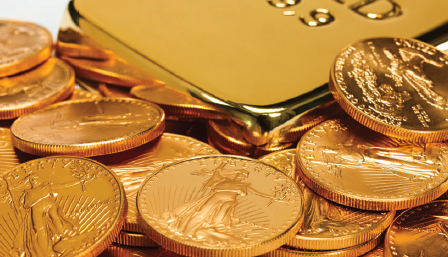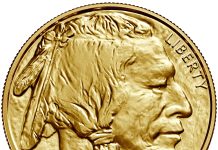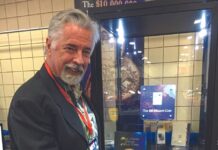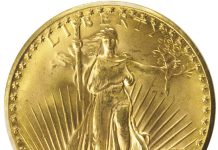
By Mike Fuljenz

Gold closed the first quarter of 2018 up 2.3%, while the Dow Jones Industrials fell 2.5%, giving gold a 4.8% advantage over the Dow index and a 3.4% advantage over the S&P 500 index. Stocks were very volatile: They rose sharply in January 2018, then fell 10% in early February 2018 – then rose and fell in waves, while gold was steady throughout the quarter, ranging from $1,310 to $1,358 per ounce.
On Monday, April 2, the first day of the new quarter, gold rose $11 to $1,337, while the Dow index fell 500 points (-1%). So gold’s advantage over the Dow was up to +7.8% as of the first business day in April. Since the dawn of the new millennium, gold is up 357% versus 110% for the Dow and 80% for the S&P 500.
Marking the 85th Anniversary of ‘Gold Prohibition in America’
In the Presidential campaign of 1932, Democrat Franklin Delano Roosevelt forcefully campaigned about the repeal of alcoholic prohibition, which had existed in America for 13 years. (It was eventually repealed by the 18th Amendment on Dec. 5, 1933). But he never uttered a word about instituting a prohibition on private gold ownership in America, which he stealthily instituted by Executive Order on April 5, 1933, just one month into office – 85 years ago. His language was harsh and authoritarian in tone:
All persons are hereby required to deliver on or before May 1, 1933, to a Federal Reserve Bank or a branch or agency thereof or to any member bank of the Federal Reserve System all gold coin, gold bullion, and gold certificates now owned by them or coming into their ownership…
Whoever willfully violates any provision of this executive order or of these regulations or of any rule, regulation, or license issued thereunder may be fined not more than $10,000, or, if a natural person, may be imprisoned for not more than ten years, or both.
An exception was made for industrial or professional use, foreign government gold or “gold coins having a recognized special value to collectors of rare and unusual coins,” but circulating gold coins were mandated for surrender. In follow-up regulations and speeches, the word “hoarding” was constantly used as a pejorative term for those wanting to hold onto their gold. Most people would call that “savings.”
After America’s privately held gold was collected in exchange for the officially set $20.67 per ounce, the President raised the official price to $35 per ounce the following January in The Gold Reserve Act of January 30, 1934, drafted on FDR’s birthday, after which he used the profits from gold’s revaluation to help fund his New Deal programs. So there was clearly a “tax collection” angle to his Executive Order.
Amazingly, this gold grab took place without consultation or consent from Congress. It lasted more than 40 years without legal challenge. Americans were forbidden to own most forms of gold as it escalated in price from $20.67 to $190 on Dec. 30, 1974, when Americans were finally allowed to own it again.
Some coins from U.S. branch mints other than San Francisco were found in the SS Central America
The explorers flooding the California Gold Rush came from all over the U.S. and the world. They brought gold from the Philadelphia Mint as well as the branch mints in New Orleans, Charlotte, and Dahlonega, Georgia, all of which were operational from the late 1830s. The San Francisco Mint was not launched until 1854. So all of the officially minted circulating U.S. gold in California prior to 1854 came from these other mints. These coins were still in circulation in 1857 and made up part of the fortune that the gold seekers were bringing home to their Eastern families when the SS Central America was lost at sea in 1857.
Within the first year of its operation, the San Francisco Mint turned $4 million in gold bullion into coins, with more coins minted each year. So the majority of the coins found in the SS Central America wreckage were San Francisco “S” mint coins, but there are quite a few from other official U.S. mints as well.
One example of a New Orleans Mint gold coin on the ship was described by Bob Evans, Chief Scientist of the SS Central America project. It was the 1854-O Quarter Eagle, counter-stamped by J.L. Polhemus, a druggist in Sacramento, California. Evans said that it was made in New Orleans at a time when the New Orleans Mint may well have been using California gold to mint coins. Evans pointed out that Gold Rush gold got around back then. Evans observed that this coin made its way all the way to Sacramento, where a shopkeeper hammered his name on it. He said that it then made it onto the SS Central America, and then, somehow, he brought it back up 150 years later, a couple of hundred miles from North Carolina. “That’s a great, full-circle journey,” Evans pointed out.
Changes made to protect lives and gold shipments after the Central America tragedy
The loss of the SS Central America made Californians think about keeping more of their wealth closer to home and not shipping so much of it out. This convinced Californians that they should start developing more industry locally rather than sending money back East. Those in the East, of course, didn’t like this idea very much. So the loss of the Central America encouraged businessmen, politicians and many editorialists at leading newspapers to promote the construction of a Transcontinental Railroad in order to avoid the risks of the sea or overland covered wagons, subject to attacks or natural barriers.
This Transcontinental Railroad opened in 1869, which led directly to the formation of the Carson City, Nevada, Mint in 1870, a mint made necessary by the discovery of silver in Nevada’s Comstock Lode.
Mike Fuljenz, president of Universal Coin & Bullion in Beaumont, Texas, is a leading coin expert and market analyst whose insightful writing and consumer advocacy have earned major honors from the ANA, PNG, NLG, and the Press Club of Southeast Texas. His website is www.universalcoin.com.
Want to receive COINage magazine in your mailbox or inbox? Subscribe today!












